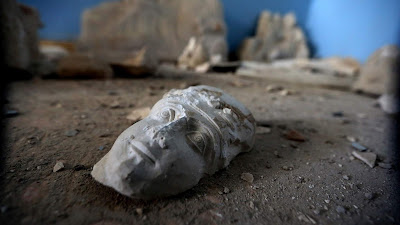Saturday, July 21, 2018 -  Carabinieri Tutela Patrimonio Culturale,Monza,Peter Paul Rubens,recovered,Renoir
Carabinieri Tutela Patrimonio Culturale,Monza,Peter Paul Rubens,recovered,Renoir
 No comments
No comments
 Carabinieri Tutela Patrimonio Culturale,Monza,Peter Paul Rubens,recovered,Renoir
Carabinieri Tutela Patrimonio Culturale,Monza,Peter Paul Rubens,recovered,Renoir
 No comments
No comments
Recovered: "The Holy Family" by Peter Paul Rubens and "Girls on the Lawn" by Pierre-Auguste Renoir
 |
| Image Credit: Carabinieri TPC - Monza Unit |
In June 2018 five individuals, were charged by the Carabinieri of the Cultural Heritage Protection Unit in Monza, Italy in connection with the theft of two paintings, "The Holy Family" (Italian: "La sacra famiglia") by Flemish artist Peter Paul Rubens and "Girls on the Lawn" (Italian: "Le fanciulle sul prato") by the French Impressionist painter Pierre-Auguste Renoir.
During the heist, which took place on April 20, 2017, one of the accomplices posed as a potential buyer, and staged an elaborate hoax, in which Nenad Jovanovic, presented himself as an Israeli rabbinical diplomat, calling himself Samuel Abraham Lewy Graham. Over the course of several appointments, the man convinced the two gallery representatives that he was a legitimate buyer, willing to purchase both works of art for a negotiated price of 26 million euros (about $30 million). Once the bait was set and the accomplices set about renting meeting space at Via Quintino Sella in Monza below the offices of the Albanian honorary consul to legitimise their ruse that the transaction for the paintings' sale was all set to be finalised.
Instead, Jovanovic, along with another accomplice, absconded with the boxes which contained the paintings using a nearby Peugeot automobile to make their getaway.
Seventeen months later, a total of eight individuals have been implicated in the crime and law enforcement authorities announced yesterday that both works of art have been recovered this week from inside a warehouse in the province of Turin.
Major Francesco Provenza of the Carabinieri has stated that the recovered canvases will now undergo scientific evaluation by experts who have been appointed by the Monza prosecutors in order to verify their authenticity and attribution.



























